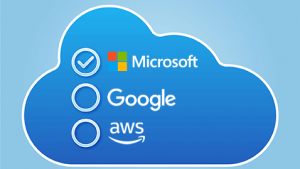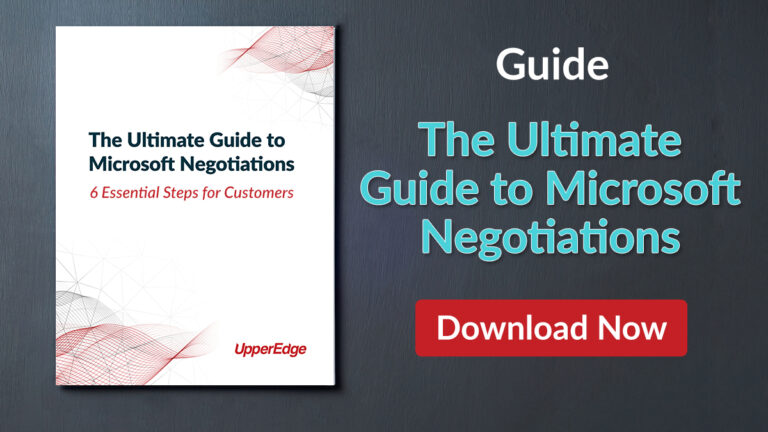- Len Riley
- Reading Time: 5 minutes

Last week, SAP announced that they’re doubling down on their relationship with Microsoft – betting big on Microsoft as their preferred cloud partner. The three-year deal is worth $225M, or $75M per year in revenue for the license rights, commencing in Q4 2019. Microsoft will resell SAP’s cloud platform services in a bundled solution with Azure. While it is not an exclusive, the ‘preferred partner’ announcement is a big change from SAP’s project Embrace, announced just five months ago.
For those who don’t remember, SAP made an effort to bring clarity to the market via Embrace, SAP’s collaboration program with Microsoft Azure, Amazon Web Services (AWS) and Google Cloud, as well as global strategic service partners (GSSPs). It is a way to move SAP customers from on-premise to the cloud, or ECC to S/4. Planned customer benefits are shorter negotiations, streamlined teaming and faster, risk-managed implementations. Embrace consists of:
- A Solution: A set of foundational services running on the SAP cloud platform to enable the integration, orchestration and extension of SAP systems and third-party applications running in the cloud or on-premise.
- A Reference architecture: A jointly developed technical blueprint that incorporates the required SAP and hyperscaler components to run the customer’s applications.
- Market-approved journeys: A jointly created and market-approved roadmap to SAP S/4HANA by industry – created with hyperscalers and global strategic service partners.
- New SAP MaxAttention services and SAP ActiveAttention services: A newly launched set of services designed to support customers running a cloud or hybrid infrastructure on a hyperscaler.
While SAP is clearly not abandoning AWS and Google Cloud, they’re certainly putting most of their eggs in the Microsoft Azure basket. Microsoft will be able to sell the bundle directly to their customers, who will run SAP in the Azure cloud.
Why Microsoft?
Before Monday’s announcement, SAP spread their bets across all, embracing everyone at an equivalent level. They’ve now picked their preferred partner, escalating their long courtship. You may remember in November 2017, they announced they were expanding their partnership to offer joint cloud capabilities and that they would be deploying each other’s solutions for their own internal operations. They would continue to cross-sell and were committed to co-engineer and support these joint solutions. This means that if SAP was running S/4 on Azure, wouldn’t it be contradictory to advise clients to run on AWS or Google Cloud Platform (GCP)?
Microsoft and SAP also have a history of navigating the complexities of “co-opetition.” They actually compete with one another in ERP and CRM solutions, but they have navigated to a place in the market where they’re comfortable and now have a long history together. In contrast, SAP has not been dating AWS or Google Cloud for very long and the relationships need time to mature. That said, SAP has clearly committed to provide customers a choice to run S/4 on AWS or GCP. However, organizations that do so will be required to contract directly with SAP.
According to Jennifer Morgan, Co-CEO of SAP,
“We already have pretty strong partnerships with both GCP and AWS, we’re users of (their) technology, and we will continue to be. There are always possibilities for the future, but today is going to start with Microsoft. The difference is Microsoft puts skin in the game, they are really teaming with us, they’re doubling down on the innovation and engineering with us. Their sales teams across the world are now selling SAP solutions. That’s going to help us do two things: accelerate the movement of S/4HANA to the cloud and accelerate the sales of SAP’s cloud platform services in cloud revenue…the stickiness of that partnership, we believe, will continue to pay a broader dividend.”
Judson Althoff, Worldwide VP of Commercial Business at Microsoft, stated it best via a LinkedIn post:
“With our renewed commitment to the Embrace program we will offer our customers a powerful combination of reference architectures, industry-specific best practices … all packaged up in a holistic bundle that makes it easy to migrate to the cloud.”
The word “renewed” clearly implies that Microsoft wasn’t totally satisfied with the previous Embrace partnership.
Microsoft vs. Google vs. AWS
While Microsoft has been sailing along with Azure sales, it is no secret that AWS still owns the majority of the hyperscaler market. And Google definitely has the potential to creep up quickly, especially with the hiring of Rob Enslin and other former industry icons. As for Google, they only have a small percentage of the market right now [for more on this, download the white paper, “Unraveling Microsoft and Google’s Battle for the Enterprise”]. At this point in time, they do not have the capabilities or reach or influence or market share in the cloud that AWS or Microsoft Azure has. Their influence and ability to move people is not at the AWS or Microsoft level. It is a point in time that Microsoft is seizing, since Google’s future potential is strong.
So that leaves AWS. There is no question that SAP would have a difficult time choosing AWS at this point. Not only is there a lack of maturity in their relationship, but AWS and Amazon are competitive with many of SAP’s customers. Take most of the retail industry, for example, who are reluctant to use AWS as they view Amazon as a current or potential competitor. For SAP to ‘embrace’ AWS in the same way as Microsoft could cause issues for some of SAP’s customers. In addition, it still remains to be seen if Amazon may present a direct competitive threat to SAP’s go-to-market strategy in the future. Another reason for SAP to walk before it runs with Amazon.
What Customers Need to be Asking
Strategically, customers should step back and determine how SAP’s relationship strategy with its partners will affect the partnership strategy of your organization. From a commercial perspective, we would advise our clients to ask these types of questions:
- What is the current contractual state of my relationships with SAP and Microsoft? Do we already have SAP cloud solutions licensed via SAP?
- What SAP cloud products are included/excluded from the bundle Microsoft is permitted to sell? Are there products in SAP’s roadmap that Microsoft has the option to resell in the future? Is there overlap with the current solutions I have already licensed directly from SAP?
- What are the economic and operational benefits of going with a bundled solution via Microsoft versus going direct to SAP?
- What is the downside of splitting my purchasing power and relationship for SAP solutions between SAP and Microsoft?
- The SAP and Microsoft agreement is only three years. Does this limit Microsoft’s ability to provide support services, renewal protections and price protections beyond three years?
- If I enter a relationship with Microsoft for SAP products, will my organization obtain the same contractual protections that I would have otherwise obtained from SAP?
The deepened partnership with Microsoft will help many customers that are struggling to shift from SAP’s traditional on-premise model to remotely hosted services. SAP’s Q4 cloud revenue was boosted by this deepened partnership with Microsoft. The question (at least one of them) is, can SAP now get to the 75% cloud gross margin they are targeting for 2023?
Comment below, follow me on Twitter @lpriley6, find my other UpperEdge blogs, and follow UpperEdge on Twitter and LinkedIn. Learn more about our SAP Commercial Advisory Services and Microsoft Commercial Advisory Services.

